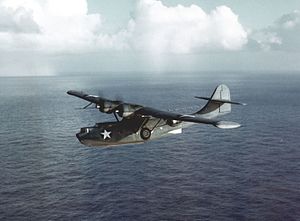PBY Catalina
| PBY Catalina | |
|---|---|
 |
|
| A PBY-5A on patrol, 1942-43 | |
| Role | Maritime patrol and search-and-rescue seaplane |
| Manufacturer | Consolidated Aircraft |
| Designer | Isaac M. Laddon |
| First flight | 28 March 1935 |
| Introduction | October 1936, United States Navy |
| Retired | January 1957 (United States Navy Reserve) 1979 (Brazilian Air Force) |
| Primary users |
United States Navy United States Army Air Forces Royal Air Force Royal Canadian Air Force |
| Produced | 1936–1945 |
| Number built | 3,305 ( 2,661 US-built, 620 Canadian-built, 24 Soviet-built) |
| Unit cost | |
| Variants | Bird Innovator |
The Consolidated PBY Catalina, also known as the Canso in Canadian service, was an American flying boat, and later an amphibious aircraft of the 1930s and 1940s produced by Consolidated Aircraft. It was one of the most widely used seaplanes of World War II. Catalinas served with every branch of the United States Armed Forces and in the air forces and navies of many other nations.
During World War II, PBYs were used in anti-submarine warfare, patrol bombing, convoy escorts, search and rescue missions (especially air-sea rescue), and cargo transport. The PBY was the most numerous aircraft of its kind and the last active military PBYs were not retired from service until the 1980s. In 2014, nearly 80 years after its first flight, the aircraft continues to fly as a waterbomber (or airtanker) in aerial firefighting operations all over the world.
The designation "PBY" was determined in accordance with the U.S. Navy aircraft designation system of 1922; PB representing "Patrol Bomber" and Y being the code assigned to Consolidated Aircraft as its manufacturer. Catalinas built by other manufacturers for the US Navy were designated according to different manufacturer codes, thus Canadian Vickers-built examples were designated PBV, Boeing Canada examples PB2B (there already being a Boeing PBB) and Naval Aircraft Factory examples were designated PBN. In accordance with contemporary British naming practice of naming seaplanes after coastal port towns, Royal Canadian Air Force examples were named Canso, for the town of that name in Nova Scotia. The Royal Air Force used the name Catalina and the US Navy adopted this name in 1942. The United States Army Air Forces and later the United States Air Force used the designation OA-10. US Navy Catalinas used in the Pacific against the Japanese for night operations were painted black overall, and as a result were sometimes referred to locally as "Black Cats".
...
Wikipedia
